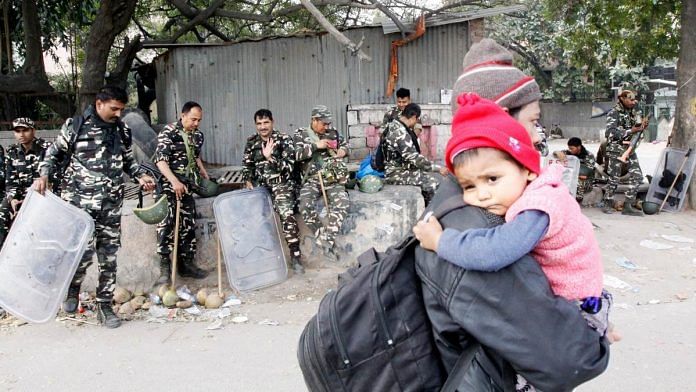On your first time in a riot-hit area, there are many things you take back home with you. The frenzied mobs carrying iron rods and cricket bats, chanting slogans, baying for the blood of the ‘others’. The deserted streets, burnt houses and cars, people crying for their deceased loved ones, the police just being witness to it all.
But there are two images that have not escaped my mind since my visit to Maujpur, which was among the many areas of Delhi caught in the communal frenzy that lasted about three days. The images are of two young boys, one carrying a cricket bat in the Hindu-dominated lanes of Baburpur and the other with an iron rod in the predominantly Muslim locality of Vijay Park.
The nonchalance with which the two boys, who did not look more than 10 years old, held their respective ‘armour’ has been etched in my memory.
Also read: ‘Never felt unsafe, now I’m scared’ — Northeast Delhi residents pack bags for safer places
Impact of Riots on Children
In a paper titled ‘Impact of Riots on Children’ by H.S. Davale, Leena Damani, Jahnavi Kedare, Shanu Jethani and Sumit Sharma for the Tata Institute of Social Sciences, the researchers explain that children and adolescents exposed to communal violence are significantly affected. They develop post-traumatic stress disorder (PTSD), which comprises many fears – of going out, of injury, of playing with kids from other communities, repeated bouts of headaches and stomach aches. These children grow up having issues like emotional denial or psychic numbing, even separation anxiety.
Reading the impact of exposure to violence, one cannot help but think of Kashmir, where, in the absence of internet and schools (which have only recently reopened), children rediscovered the ‘military-mujahid’ game, where some kids play the role of army officers and others mujahids to engage in a fictional gun battle.
While watching one of the videos from Vijay Park in Delhi, a colleague remarked that it looked like Downtown, Kashmir. In the face of violence, perhaps all places, fears, and emotions look the same.
In times where lynching becomes normal without perpetrators facing any consequences, where detention of innocent protesters and reenactment of the destruction of a mosque don’t lead to public outrage, where does society look for hope while raising kids? Can something like the ‘happiness curriculum’ in school save childhood and pay attention to their needs when they really need it the most? One can only hope so.
Because however much we want to believe it, happiness cannot be found in the darkest of times by simply turning on the light.
Also read: Anger towards ‘other side’ echoes in Hindu-dominated areas of riot-hit Northeast Delhi
Seeds of hatred
During the 1993 Bombay riots, an 11-year-old girl wrote this poem:
Blood, blood all around; Blood, blood on the ground;
Bang, bang and a cry; Blood, blood I don’t know why?
This shows how violence seeps into children’s subconscious and takes over their imagination. Their stories become punctuated by images of blood and mayhem. The innocence or unadulterated love that one usually associates with children transforms into something completely unfamiliar, just as their toys and games turn into constant reminders of how their lives have been changed and not for the good.
Thinking about those two boys I saw in Maujpur, I cannot help but wonder: what will they grow up to be? What will the rest of their childhood look like?
I can only hope they do not grow up to be someone like this woman in one of the Hindu-dominated areas who offered me tea and lunch, thinking I was a student looking for my sister. She called me beti and asked me to wait until the violence had subsided. But this affection was measured and calculated because this beti was a Hindu. On the mention of the word ‘Mohammedan’ and she started uttering the vilest of things. She too was once a child, pure and not bigoted, when she did not hold such visceral hatred against people she has never met.
The fear is that the seeds of hatred and distrust may have already been sown into so many children of today.
But there will always be some hope. Among the many tales of violence and hate and murder in Delhi riots was this: Vipan (12) asks his friend Ayan over phone, “Tum theek ho? (are you okay?)” And Ayan responds by asking, “Haan, tum theek ho? (yes, are you?)”
"Tum theek ho?" little Vipan (12) asked his school friend Ayan over the phone.
"Haan, tum theek ho?" Ayan asked Vipan. Vipan lives in #Maujpur, Ayan in #NoorIlahi, both riot-hit areas in northeast Delhi. Their friendship is intact through all this. #DelhiRiots2020
— Somya Lakhani (@somyalakhani) February 27, 2020
The fear and cynicism takes a back seat and leaves a sense of hope, of perhaps finding happiness in the darkest of times. Not by turning on the light, but by rejecting hate, believing in friendships and standing up for ‘others’. This holds out more for those two boys, the ones with a cricket bat and an iron rod roaming nonchalantly in the streets of violence.




You re right. However, must MOST certainly add so it is for all the kids at all places of riots everywhere